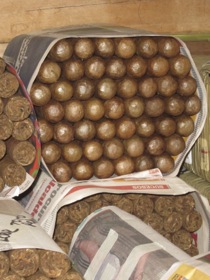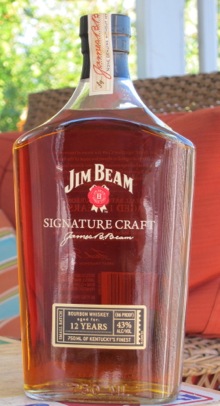Cigar Review: Quesada Oktoberfest Dunkel
2 Oct 2013
Arturo Fuente’s Solaris. Tatuaje’s Anarchy and Apocalypse. My Father’s El Hijo. Padrón’s 1964 Anniversary SI-15. Room 101’s Big Delicious. What do these have in common?
 They’re all part of the Microblend Series that’s soldby Smoke Inn, a Florida-based cigar retailer. The Microblend Series is inspired by the growing popularity of U.S. microbreweries, harnessing how “limited production quantities allow for a greater emphasis to be placed on quality and consistency,†according to the Smoke Inn website.
They’re all part of the Microblend Series that’s soldby Smoke Inn, a Florida-based cigar retailer. The Microblend Series is inspired by the growing popularity of U.S. microbreweries, harnessing how “limited production quantities allow for a greater emphasis to be placed on quality and consistency,†according to the Smoke Inn website.
With that inspiration, it was only a matter of time before Smoke Inn partnered with Manuel Quesada to put new twist on one of Quesada’s most popular lines: Oktoberfest. Just in time for the German festival, Smoke Inn is now shipping the Oktoberfest Dunkel, named for the German word for “dark†that’s typically used to describe a dark lager.
“In the spirit of Oktoberfest, the Dunkel uses the same binders and fillers of the regular Oktoberfest release, with the exception of the wrapper,†reads a Smoke Inn press release. “A very select broadleaf maduro wrapper envelops this rich cigar with a slight underlying Ecuadorian Connecticut wrapper at the foot, thus giving the appearance of a dark, rich Dunkel beer with a savory, foamy head.â€
Dunkel is sold in one size (6 x 54) at a cost of $8.95 per single, or $134.25 per box of 15. It’s obviously a unique-looking cigar, which may be why Quesada chose to keep the band exactly the same as the regular Oktoberfest blend. Aside from the different wrapper at the foot, Dunkel’s other aesthetic properties include a tremendously oily exterior, pungent pre-light notes of earth and cocoa, and a dense, firm feel.
The initial profile is reminiscent of the original Quesada Oktoberfest with dark cherry, burnt coffee, and an occasional bitter bite. Sweet notes are more apparent on the aftertaste than each individual puff. But during the outset of the smoke—the one covered in the Ecuadorian Connecticut wrapper—the texture is very creamy.
Spice and leather take center stage once the cigar passes into the broadleaf maduro phase. Here the Dunkel becomes more full-bodied with a little more nicotine kick. Perhaps not surprisingly, though, the creaminess prevails, rendering Dunkel one of those flavorful smokes with ample spice and complexity yet a creamy undertone.
All of the Quesada Oktoberfest Dunkels I smoked for this review exhibited admirable physical properties, and all were, quite frankly, a joy to smoke. While I’m no fan of pairing beer with cigars—as I’ve written before—the quality of this smoke is undeniable regardless of pairing. That earns it a solid rating of four stogies out of five.

[To read more StogieGuys.com cigar reviews, please click here.]
photo credit: Stogie Guys

 Everything from the basic definition — It’s aging after one year. No, that’s still resting; aging starts after three years. Well, I think two years is when it starts. — to which cigars benefit most from the process is a veritable minefield.
Everything from the basic definition — It’s aging after one year. No, that’s still resting; aging starts after three years. Well, I think two years is when it starts. — to which cigars benefit most from the process is a veritable minefield. These days, Miami is witnessing somewhat of a renaissance in cigar making. Crémo Cigars, launched near the end of 2011, is part of this revitalization, proudly proclaiming its commitment to American production. Crémo’s blends are crafted at the El Titan de Bronze Cigar Factory on Miami’s Calle Ocho. The factory is “known best for its old-school Cuban entubado techniques, [and] is a family-owned and operated ‘fabriquita’ which employs level-nine rollers from Cuba,†according to the Crémo
These days, Miami is witnessing somewhat of a renaissance in cigar making. Crémo Cigars, launched near the end of 2011, is part of this revitalization, proudly proclaiming its commitment to American production. Crémo’s blends are crafted at the El Titan de Bronze Cigar Factory on Miami’s Calle Ocho. The factory is “known best for its old-school Cuban entubado techniques, [and] is a family-owned and operated ‘fabriquita’ which employs level-nine rollers from Cuba,†according to the Crémo 



 In addition to Jim Beam’s standard White Label bourbon (four years), Noe is responsible for Beam Black (eight years) and the small batch collection that includes
In addition to Jim Beam’s standard White Label bourbon (four years), Noe is responsible for Beam Black (eight years) and the small batch collection that includes  Patrick Ashby
Co-Founder & Editor in Chief
Patrick Ashby
Co-Founder & Editor in Chief Patrick Semmens
Co-Founder & Publisher
Patrick Semmens
Co-Founder & Publisher George Edmonson
Tampa Bureau Chief
George Edmonson
Tampa Bureau Chief